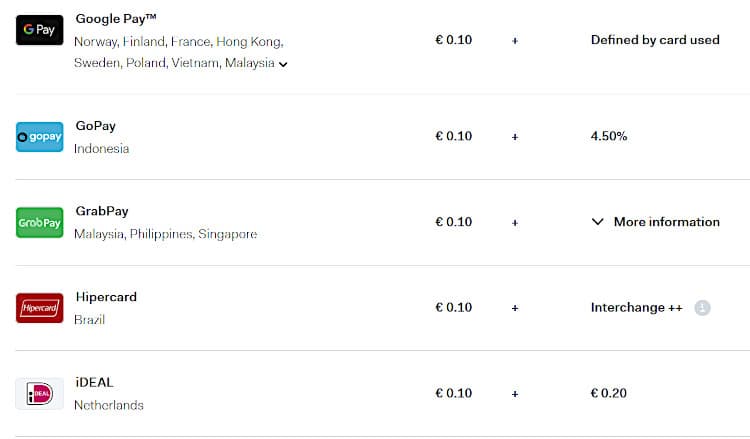Adyen Stock is a Pure Play on Digital Payments Processing

How many ways can I pay thee? Let me count the ways. Actually, let’s not even try, because it’s not anywhere near as straightforward as a haircut for two bits. Are we talking about B2B payment technology or something more niche like restaurant transactions with digital receipts? Cryptocurrency? Let’s not even go there.
For the last couple of years, we’ve tracked three digital payments fintech stocks, eventually investing in the one that we felt offered the best growth opportunities and diversification. With the air rapidly going out of the current dot-com.2 bubble, we recently re-evaluated our strategy and promised to dive more deeply into the businesses of both PayPal (PYPL) and Adyen (ADYEN.AS). In this article, we’ll mostly focus on our current investment, Adyen stock.
Adyen: eBay’s New Pal
One thing that is immediately clear is that these digital payments companies are actually quite different. Most of us are probably familiar with PayPal, which is one of literally hundreds of different payment methods that merchants accept for goods and services – albeit the most popular and ubiquitous one. Don’t want to bother entering your credit card info on yet another website to buy more stuff made in China? Just hit the PayPal button, verify the account, and you’re done. Or just Venmo someone using the PayPal subsidiary. PayPal is also a popular way to send money, though we’ve found better options with fewer fees.
It became the OG of fintechs thanks to its close relationship with eBay for much of its nearly 25-year-long history. In fact, the online auction retailer owned PayPal for more than a dozen years before splitting the business off again in 2015. The divorce got particularly ugly in 2018 when eBay started going steady with Adyen and replaced PayPal as the de facto payments processor. But Adyen is not PayPal.
How is Adyen Different from PayPal?
Adyen, in contrast, offers a turnkey payments platform for enterprises and merchants to accept about 250 different kinds of payments digitally and at point of sale (POS) in dozens of countries and in more than 120 currencies. It’s an important distinction and why you probably never heard of Adyen, because it works behind the scenes by providing merchants a standardized back-end infrastructure for authorizing payments across their sales channels – online, in-app, and in-store. It is not a consumer-interfacing product with name recognition like PayPal or Venmo.

While you may not be familiar with the Amsterdam-based fintech, you’ve probably heard of some of its 4,500 customers. In addition to eBay, Adyen counts Facebook, Uber, Airbnb, Netflix, Spotify, Dropbox, Booking.com, Yelp, and Vodafone among the companies using its payments platform. These enterprise customers are the bread and butter of the company’s business.
How Does Adyen Make Money?
Founded in 2006, the company had raised $266 million in funding before going public in 2018. Four years and one market downturn later, Adyen sports a market cap of $50 billion, with shares trading at more than $1,600 each on the Amsterdam Stock Exchange (all values are as of May 27, 2022 and converted into U.S. dollars from euros). As you might expect in a world that is increasingly heartless touchless, a company specializing in digital payments processing did pretty well in 2021.

Let’s start with revenues. Adyen increased revenues by more than 60% last year to about $6.4 billion, with earnings up more than 55% to about $500 million. The company derives most of its revenue from settlement and processing fees it charges to merchants. This so-called interchange ++ model means Adyen charges a nominal processing fee ($0.11) per transaction plus a little bit on top of what each third-party vendor charges. For example, a merchant will be charged 3% for Alipay but between 3% and 7% for something called YooMoney, plus 11 cents. Its prices are transparent and published online.

Adyen processed more than $550 billion through its payments platform in 2021, a 70% year-on-year increase in payment volume. The majority of its annual volume growth – better than 80% from each half-year period since the 2018 IPO – comes from the growth of merchants already on its platform. And while POS volume makes up a relatively small portion of that $550 billion at 13%, it was up 100% from a year ago, as the company focuses more energy on that segment of the business. Those are pretty good results given the amount of competition developing POS tech solutions. Revenues and costs for sales of goods are mainly related to that part of the business, such as the sale of POS terminals.

Readers who recall our piece on the importance of gross margins might be confused – as we are – as to how cost of goods sold (COGS) interacts with “costs incurred from financial institutions.” In this case, the latter simply represents fees charges for transactions by merchants that are passed on to the third party vendors they work with. For all practical purposes, we can just sum the two line items and calculate “gross margin” which comes out to about 16.7%. A lower gross margin happens to be characteristic of the type of business that Adyen operates, and therefore doesn’t solicit the same concerns around “survivability” as it may in other firms.
It’s worth noting that Adyen does not accept any kind of cryptocurrency after briefly flirting with bitcoin a few years back. Pieter van der Does, the firm’s CEO and co-founder, told CNBC that crypto is too volatile for making transactions and that his company has no interest in adding it as a payment method. “Bitcoin is more of an investment asset than a payment method,” Van der Does said in an interview last year. While we hold just a bit of bitcoin for the sake of diversity, we have long viewed the crypto world at large as another get-rich-fast scheme. Glad to see that Adyen has come to the same conclusion.
What Other Financial Services Does Adyen Provide?
While digital payments processing is the company’s core competency, Adyen is branching out into other financial services. For example, since 2019, it has provided a credit card issuing service that customers can brand and manage, including everything from corporate cards to travel awards programs. More recently, the company announced it would roll its card issuing business into a broader financial products suite. Among the forthcoming products are multi-currency accounts, allowing users to receive payments, initiate payouts, and safely store money all in one place. These accounts will also enable platform clients like eBay to extend financing to small-business users who are pre-qualified based on Adyen’s data-driven risk-scoring algorithms.

The company also employs machine learning software to prevent fraud, unlock business intelligence from data, and optimize the millions of transactions that flow through its platform. Unlike PayPal, which has acquired nearly two dozen companies over the years, all of Ayden’s tech is homegrown.
Is Adyen an ESG Company?
Based on the company’s growth, the big brains behind the algorithms and other technologies are earning their keep. No doubt these folks are getting paid well, with the usual European perks of working life. In fact, Adyen devotes about 30 pages outlining its various ESG efforts to keep employees happy and save the planet. This is only a “concern” when a company sacrifices the bottom line for bourgeois causes. The Dutch are usually in the top five when it comes to those “who are the happiest people on Earth” polls, so you’re going to get some of that, along with tables like these in the annual financial summary:

It’s a well-known fact that whether you sit down or stand up to take a piss makes a huge difference in your ability to manage people, so it’s great to see they’re focused on what matters. Still, much of the company’s ESG efforts are also linked to its technology by providing functionality for charitable giving and even carbon off-sets without charging fees. These sound like useful and easy-to-absorb efforts, while also appeasing ESG types, including lingo about aligning with United Nations’ Sustainable Development Goals. As long as they’re not contributing to charities in the name of shareholders, then we’re kosher with these ESG window dressings.
Is Customer Concentration a Concern?
One of the things that first attracted us to Adyen is that the company offers the sort of exposure to both foreign currency and geographic diversification lacking in many companies. That’s only improved with time: Less than two years ago, more than half of the company’s revenues came from Europe. Now, North America is driving growth:

Our main concern here is customer concentration: Adyen’s top 10 merchants represented 29% of revenue last year, but even that metric is improving, dropping from 38% in 2020. The number suggests that losing a couple of major clients wouldn’t completely torpedo the company’s continued growth, especially as new financial products come online.
Conclusion
Since its IPO in June 2018, Adyen has returned more than +250% compared to a +45% return on the Nasdaq over the same time frame. Despite growing revenue (18%) and transaction volume (33%) in 2021, PayPal is currently in negative territory for the same time period. While it could be tempting to dismiss Adyen as another pandemic stock, the trend toward digital financing is much bigger than one virus. Remember that another growth driver is POS revenue, which generally means in-store transactions. Adyen appears to have the traction, scale, and technology to be the payments platform of choice for both e-commerce and brick-and-mortar.
So far, it looks like the underdog is the overwhelming favorite to remain in our Disruptive Technology Portfolio, but we’ll take a deeper dive into PayPal to sanity check that declaration in the near future.







